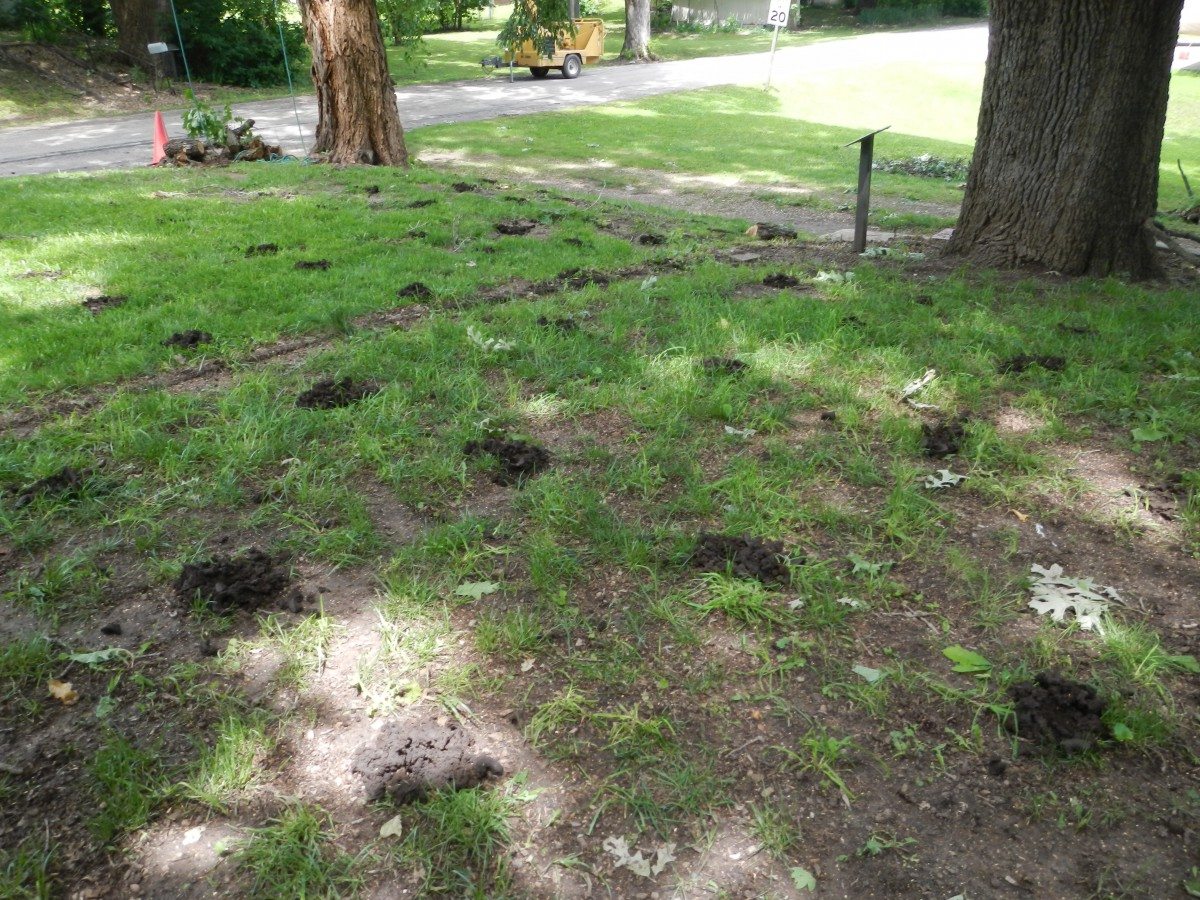Monitor for needlecast and blight diseases on older foliage where new foliage is emerging on Austrian pine and Colorado spruce.
Believe it or not, purplish-coloured falling needles are not a diagnostic sign of needlecast disease on spruce, especially Colorado spruce (Picea pungens). It takes a horticultural expert (that’s you) to diagnose this fungal disease. First, you will want to assess the site: the soil conditions and texture, level of compaction, size of root zone compared to size of tree, any root zone disturbances in the last 5-10 years, proper planting depth (exposure of root flare to the air), and any signs of sap streaking on trunk or branches (symptoms of mechanical injury, pest or just stress response) site history and competition for light and other resources.

For this Colorado spruce, there are other factors going on that would result in such a high percentage of needle loss. And in fact when we take a closer look, we can see that this tree has soil piled up over the root/trunk flare, leading to dieback of tissues under submerged bark.
In this example, we can see Colorado spruce is mixed with other evergreens as a privacy fence and there has been needlecast on the Colorado’s. When we crowd canopies in together like this, we create pockets of dead air…leading to increased leaf wetness periods and high humidity, which are perfect conditions for needlecast diseases.
To confirm it is indeed Rhizosphaera needlecast disease, look at the STOMATES with your hand lens. Those little white dots are the stomates (lower healthy needle) and they will erupt with smooth black fruiting structures (pycnidia) of the fungus Rhizosphaera (upper needle) after they have been infected and colonized. They can be visible on needles that are dying while still attached to the twig, as well as those that have fallen.
Colorado spruce (Picea pungens) are one of our most common hosts for needlecast diseases in Ontario. Needles are infected in spring and summer, especially in warm, wet weather. The fungus has been found sporulating throughout most of the growing season, but foliage is likely most vulnerable during the leaf emergence period. Protect new growth with fungicides such as Banner MAXX, Copper, Daconil, Flint. Repeat application 14-21 days later where leaf wetness periods occur throughout leaf emergence.
Needles infected the previous year will start to show symptoms of discoloration the following years. Older needles on lowermost branches that receive afternoon shade will be showing the most signs and symptoms of Rhizosphaera. These infected older needles will drop in summer, leaving trees looking barren.
Here’s an example of needlecast on Colorado spruce where the needles have already fallen. Notice how it’s just one section of the tree? We traced each symptomatic branch back to look for signs of weeping or bark discolouration, there were none. On a hunch I asked the client to run the sprinkler system and we watched mesmerized as the irrigation stream ran right through this section of the tree. Managing Leaf Wetness Periods are a very important part of disease management.

Spikey-looking spordochia (fruiting structures) of Stigmina lautii bursting out of stomates (photo: msue.anr.msu.edu)
In addition to Rhizosphaera needlecast, Stigmina Needle blight (Stigmina lautii) can also be found on spruce (Colorado, Norway and white) and appears as black, spiked-looking fruiting structures (sporodochia) pushing through stomates on green and reddish-brown needles. Quite often, the infected, symptomatic needles won’t drop until the following year. Pathologists have observed trees with both Stigmina and Rhizosphaera infections (on the same tree). If needles are green but stomates look black, chances are its Stigmina and not Rhizosphaera.
New, soft growth is especially susceptible to foliar diseases, but infection may also take place later in the season. Where there is a history of damage, treat with registered fungicides (copper oxychloride, Banner Maxx, Daconil) as new twigs start to elongate and protect new foliage. Where necessary, apply fungicides prior to precipitation events (spore dispersal).
Diplodia tip blight (Sphaeropsis sapinea) on 2 and 3 needled pines can be a significant disease of pine, especially on stressed Austrian pines in the urban landscape.

Photo credit: hyg.ipm.illinois.edu
Diplodia tip blight appears as brown, stunted needles at the tips of branches and black fruiting structures of the fungus are often visible on past year’s dead needles (and cones) after rainy days.
Unfortunately, most of these blights and needlecasts can be found sporulating for much of the year so management can be difficult.
 Methods that improve air pore space in the root zone (e.g. soil aeration and methods such as vertical and radial mulching) can help relieve compaction issues and provide conditions more favorable to root growth of evergreen trees in the landscape (Photo credit: cmtrees.com). Many landscape professionals have seen huge bursts in canopy growth and vigour the years following root zone aeration and the addition of organics.
Methods that improve air pore space in the root zone (e.g. soil aeration and methods such as vertical and radial mulching) can help relieve compaction issues and provide conditions more favorable to root growth of evergreen trees in the landscape (Photo credit: cmtrees.com). Many landscape professionals have seen huge bursts in canopy growth and vigour the years following root zone aeration and the addition of organics.







